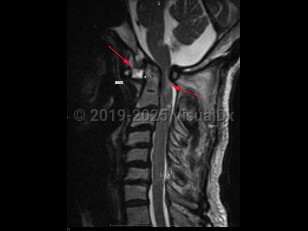Atlantoaxial instability
Alerts and Notices
Important News & Links
Synopsis

Atlantoaxial instability (AAI) is defined as excessive motion between the first cervical vertebra, the atlas, and the second cervical vertebra, the axis. The atlantoaxial segment is an anatomically complex section of the spinal column, composed of unique bones, articulations, and ligaments, with critical neurovascular structures intimately involved. The atlantoaxial segment is responsible for significant motion in the spine, and, in fact, is responsible for over half the possible axial rotation of the cervical spine. Disruptions of any of the ligaments or articular processes that afford nonpathologic motion of the atlantoaxial segment may result in instability of the complex. AAI can occur due to trauma, rheumatoid arthritis, congenital abnormalities (including up to 20% of Down syndrome patients), degenerative changes, head and neck infections, neoplasms, or iatrogenic etiologies. Most commonly, AAI results from compromise of the ligamentous complex; however, fractures or destructive processes affecting the osseous elements may also result in AAI.
AAI can occur in 3 directions: rotation, flexion-extension, and distraction leading to excessive displacement, which can result in subluxation or even dislocation.
Rotatory subluxation is most common in pediatric patients with congenital abnormalities and presents with neck pain and frequently a classic "cock-robin" head position (head is tilted, rotated, and slightly flexed). Rotatory subluxation can also occur after minor or major trauma or local infection (eg, Grisel syndrome).
Anterior atlantoaxial subluxations are more common in adults and result from any of the pathologies listed above. Anterior subluxations result in neurologic deficits or death in one-third of patients. Patients with rheumatoid arthritis (RA) are at most risk for dislocation in the anteroposterior (AP) plane but can develop rotational AAI as well.
Posterior atlantoaxial subluxations are rare and often occur from erosion of the odontoid process of the axis.
AAI can occur in 3 directions: rotation, flexion-extension, and distraction leading to excessive displacement, which can result in subluxation or even dislocation.
Rotatory subluxation is most common in pediatric patients with congenital abnormalities and presents with neck pain and frequently a classic "cock-robin" head position (head is tilted, rotated, and slightly flexed). Rotatory subluxation can also occur after minor or major trauma or local infection (eg, Grisel syndrome).
Anterior atlantoaxial subluxations are more common in adults and result from any of the pathologies listed above. Anterior subluxations result in neurologic deficits or death in one-third of patients. Patients with rheumatoid arthritis (RA) are at most risk for dislocation in the anteroposterior (AP) plane but can develop rotational AAI as well.
Posterior atlantoaxial subluxations are rare and often occur from erosion of the odontoid process of the axis.
Codes
ICD10CM:
M24.80 – Other specific joint derangements of unspecified joint, not elsewhere classified
SNOMEDCT:
202820009 – Atlantoaxial Instability
M24.80 – Other specific joint derangements of unspecified joint, not elsewhere classified
SNOMEDCT:
202820009 – Atlantoaxial Instability
Look For
Subscription Required
Diagnostic Pearls
Subscription Required
Differential Diagnosis & Pitfalls

To perform a comparison, select diagnoses from the classic differential
Subscription Required
Best Tests
Subscription Required
Management Pearls
Subscription Required
Therapy
Subscription Required
References
Subscription Required
Last Reviewed:08/09/2017
Last Updated:08/16/2017
Last Updated:08/16/2017
Atlantoaxial instability

